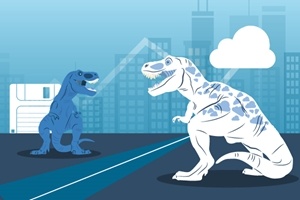2015 was a banner year for reboots, revivals and retrospectives. Two film franchises that had not received new main line releases in at least a decade - "Star Wars" (2005) and "Jurassic Park" (2001) - saw their latest installments shatter box office records worldwide. Meanwhile, the long-awaited "Back to the Future Day" came and went on Oct.21, 2015, bringing to life one of the most famous dates in movie history from 1989's classic "Back to the Future II." The vintage 1981 video game character Mario, created by Nintendo, also appeared in a slew of nostalgia-drenched games this past year, including the Wii U smash hit "Super Mario Maker."
A different, and less enjoyable, wave of retromania washed over enterprise software throughout 2015. While all of those iconic film and gaming properties were being brought back to the fore, professional services firms, nonprofits and SMBs everywhere continued to stick with aging solutions - out of what seemed like necessity, rather than by their own choice, in many cases - for tasks like enterprise resource planning and customer relationship management. Some of these tools probably felt like they came from the same bygone worlds that produced the first "Star Wars" film or the debut "Donkey Kong" arcade cabinet.
What's old is new: Legacy ERP still alive and well heading in 2016
Let's look at challenges with ERP in particular. The dream of "futuristic" ERP solutions has been floated for years now, if only because legacy ERP has become synonymous with enormous, slow-moving architectures (real dinosaurs, unlike the fast-moving hybrids of "Jurassic World") that can feel as expensive to implement and maintain as a large theme park. For example, a failed ERP project in 1999 prevented Hershey's from delivering $100 million worth of candy. The headaches certainly didn't stop with the famed chocolate maker:
- According to Mint Jutras statistics from 2014, 58 percent of manufacturers reported that they were doing excessive non-value-added work, such as redundant data entry, because they did not have suitable ERP solutions. In this way, an outmoded ERP system can be indistinguishable from just managing everything by hand in an Excel sheet - i.e., highly inefficient and not scalable.
- The introduction to the 2014 ERP Report from Panorama Consulting Solutions revealed that between 2010 and 2013, the average ERP implementation had cost $6.5 million and lasted more than 16 months. Both of these figures represent considerable overruns for their planners, at 54 percent and 72 percent of all projects, respectively.
- At the same time, the enormous expenses involved in getting an ERP system up and running do not always - or even most of the time - offer good return on investment. The same document from Panorama found that two-thirds of organizations reported getting less than half of the measurable benefits they initially expected from their ERP software.
These findings simply confirm the deep problems that a lot of firms have been experiencing with their ERP systems for many years now. Legacy ERP can often feel like a giant old jigsaw puzzle in which a significant portion of the pieces are now either missing or ill-fitting. Accordingly, it is hard to piece everything (e.g., data, reports, software upgrades, etc.) together and the overall user experience is one of frustration:
Outdated hardware and software
Legacy IT infrastructure is not as easy to update for 2015 and 2016 as an old movie franchise or gaming series. More specifically, older systems may lack now-essential security mechanisms as well as any ability to tap into modern APIs. Direct support may also have to be ad hoc, given the number of IT vendors that have gone out of business since many of today's still-in-use ERP systems were first implemented. Even if the seller is still around, it may charge you a hefty sum to service a legacy ERP product, making it not just advisable but also cost-effective to consider moving on to a newer platform.
"Legacy IT infrastructure is not as easy to update for 2016 as an old movie franchise."
Limited functionality
Many classic films, albums and video games are defined by, and loved because of, their technical limitations. Stanley Kubrick's "2001: A Space Odyssey" was shot in super widescreen 70mm film, The Beatles' "Sgt. Pepper's Lonely Heart Club Band" was recorded on a 4-track and many of the most memorable games of the 1980s and 1990s were filled with low-res pixelated graphics. Yesterday's ERP tools are a different story - they're well-known, but not exactly adored, for their constraints. They do not always allow for easy collaboration or support core activities such as business intelligence and consolidated financial management.
High price tags
"Sticker shock" refers to someone's surprise at how high a new product's price is. Something similar, but directed at old systems, must affect the numerous IT and business departments that look into the costs of maintaining their ERP architectures. Extensive customization and constant tweaking can quickly add up, making an inadvertent case for switching to cloud ERP software.
"The need for agility and responsiveness has led highly customized ERP implementations to an impasse, creating a subset of legacy ERP installations that must be dealt with constructively," said Andy Kyte of Gartner in January 2014. "Early ERP adopters, particularly large enterprises in energy, manufacturing and distribution industries, are paying the penalty of a decade or more of excessive customization."
Cloud ERP is the ticket for 2016
In the aforementioned Panorama study on ERP, the vast majority of all ERP implementations were of the on-premises variety. In fact, the number of survey respondents stating that they were on the path to cloud ERP actually declined between the 2013 and 2014 editions of the report, demonstrating the strong ongoing influence of legacy ERP tools and practices.

Cloud ERP promises a bright future for businesses.
But the tipping point for cloud ERP may be coming up soon. An official summary of the 2015 ERP Report from Panorama and Mint Jutras stated that the share of respondents setting up new SaaS solutions for ERP surged from 4 percent in 2014 to 33 percent in 2015. While cloud ERP still makes up a small portion of all ERP systems, its benefits are becoming increasingly apparent as businesses look to contain costs and modernize their day-to-day operations.
What can cloud ERP do? For starters, it's much easier on the company wallet than its traditional counterpart. A November 2014 PricewaterhouseCoopers report, summarized by Forbes contributor Louis Columbus, estimated that a hybrid ERP system could save six times the capital invested cumulatively as a legacy solution. Cloud software also follows a convenient subscription-based billing model.
PwC predicted that by 2016, investment in SaaS solutions would more than double from 2014 levels to to $78 billion. We'll see if that pans out in the coming year as the appeal of cloud ERP increases. In addition to the potential savings for businesses, cloud ERP also provides customizable user interfaces, integration of functions across the supply chain and built-in CRM and financial management, among many other features.
Like 2015, 2016 may keep the nostalgia train chugging along, especially when it comes to movies and games. Everything from "X-Men" to "Star Fox" is getting a new coat of paint in 2016. As this happens in the background, don't get too attached to your old ERP system if it isn't working out for you anymore; don't keep customizing it if you don't have to. Cloud financial software is the ticket to a more cost-effective and productive future for your business.




